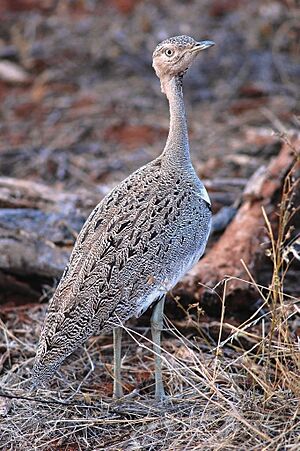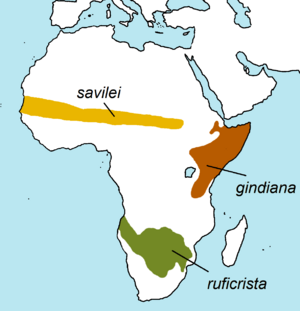Buff-crested bustard facts for kids
The buff-crested bustard (Lophotis gindiana) is a medium-sized bird found in East Africa. It belongs to a bird family called Otididae. Good news! There are plenty of these birds, so they are not considered in danger.
Quick facts for kids Buff-crested bustard |
|
|---|---|
 |
|
| Conservation status | |
| Scientific classification | |
| Genus: |
Lophotis
|
| Species: |
gindiana
|
 |
|
| Range of Lophotis gindiana | |
Contents
About the Buff-crested Bustard
The buff-crested bustard is a medium-sized bird from East Africa. It can grow up to 60 centimeters (24 inches) tall. This makes it quite small compared to other bustards in Africa.
Male buff-crested bustards usually weigh between 675 and 900 grams. Adult males have a black stripe that runs from their throat down to their chest. Their feathers are mostly grey or buff, except for this black stripe and a dark belly.
In this bird family, males and females often look different. This is called being sexually dimorphic. Females have a duller stripe on their throat. Their grey feathers are replaced by a light brown color.
These birds spend most of their time on the ground. Because of this, they do not have a back toe and do not perch on branches. The male birds have a special colored feather crest on their head, which gives the bird its name. Females do not have this crest. When the bird spreads its wings, you can see a large white patch under each wing.
Bird Families: Taxonomy
The buff-crested bustard (Lophotis gindiana) is part of the Otididae family. This family is also known as the bustard family. There are 25 different kinds of bustards alive today.
The Lophotis group includes the Savile's bustard, the red-crested bustard, and the buff-crested bustard. These three birds are sometimes thought to be the same species because they look and act alike.
The buff-crested bustard was once called Eupodotis ruficrista gindiana. This was when it was considered a type of red-crested bustard. However, new studies of their genes show that Lophotis is a separate group of birds.
Where They Live: Habitat and Distribution
Buff-crested bustards live across East Africa. They are most commonly found in Ethiopia. In Ethiopia, you can see them in the southern parts, east of the Rift Valley.
These birds do not migrate, meaning they stay in the same area all year. They live in countries like Sudan, Somalia, Eritrea, Uganda, Tanzania, and Kenya.
They prefer dry, thorny scrublands and rocky desert areas. In Kenya, they like dry to semi-dry climates. You won't find them in humid areas near the coast. Unlike many other bustards, they prefer places with stony or sandy soil, not tall grasses. The female's light brown feathers help her blend in perfectly with these dry environments.
How They Live: Behaviour
Bird Calls: Vocalizations
You are more likely to hear a buff-crested bustard than to see one. Their calls are strong, short whistles.
During mating season, males make a series of loud, fast whistles. These sounds are like "kri-kri-kri" and slow down towards the end.
What They Eat: Diet
Scientists don't know much about what buff-crested bustards eat in the wild. However, birds kept in zoos have been fed different foods. These include mice, mealworms, crickets, and pieces of apple and cabbage. They also eat special bird pellets.
Raising Young: Reproduction
During spring and summer, which is their mating season, male bustards perform amazing aerial shows. They do this to impress females and get chosen for mating.
A male will fly straight up into the air, sometimes as high as 30 meters (about 100 feet). Then, he will stop in mid-air and drop towards the ground with his wings folded. Just before hitting the ground, he opens his wings and lands suddenly.
Normally, both male and female bustards don't like to fly much. They prefer to sneak away from danger on the ground.
One interesting thing was seen with a female buff-crested bustard in captivity. She was observed carrying her newborn chicks! She would carry one chick at a time under her wing. Then, she would drop it in a new, desired spot. It's not known if wild bustards do this too.
Female bustards usually lay 1 or 2 eggs. They make their nests right on the ground.


